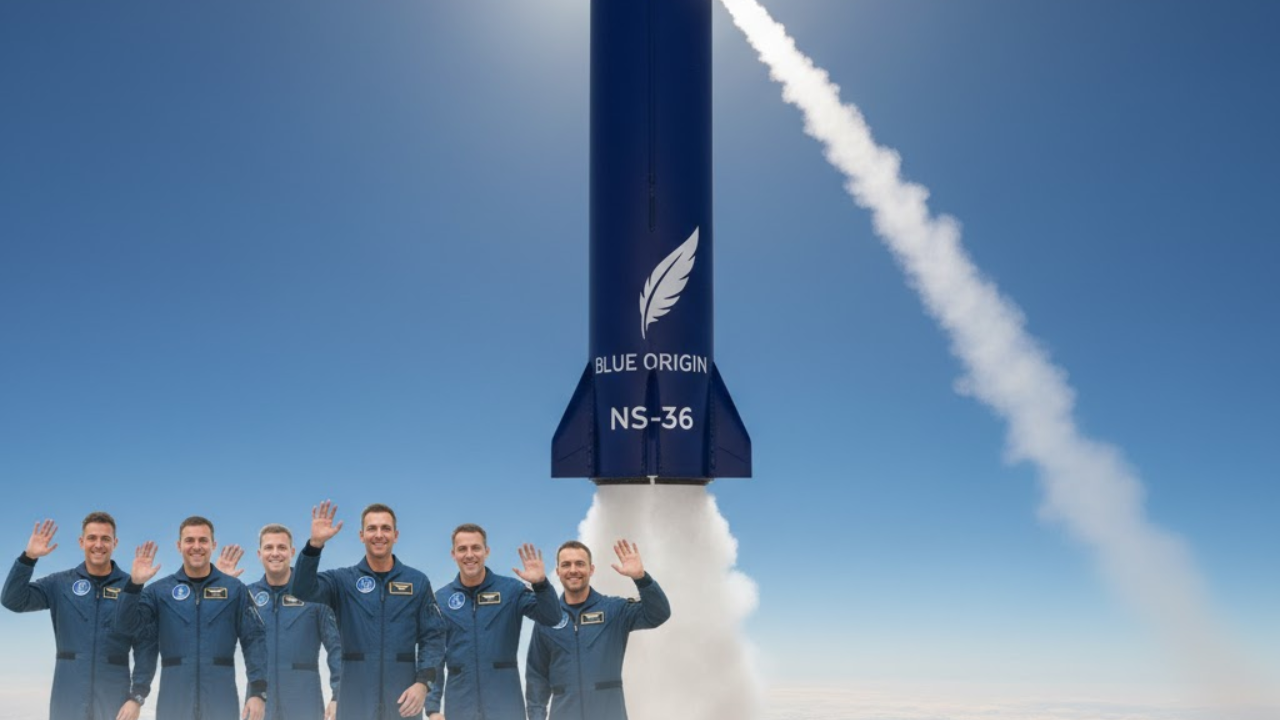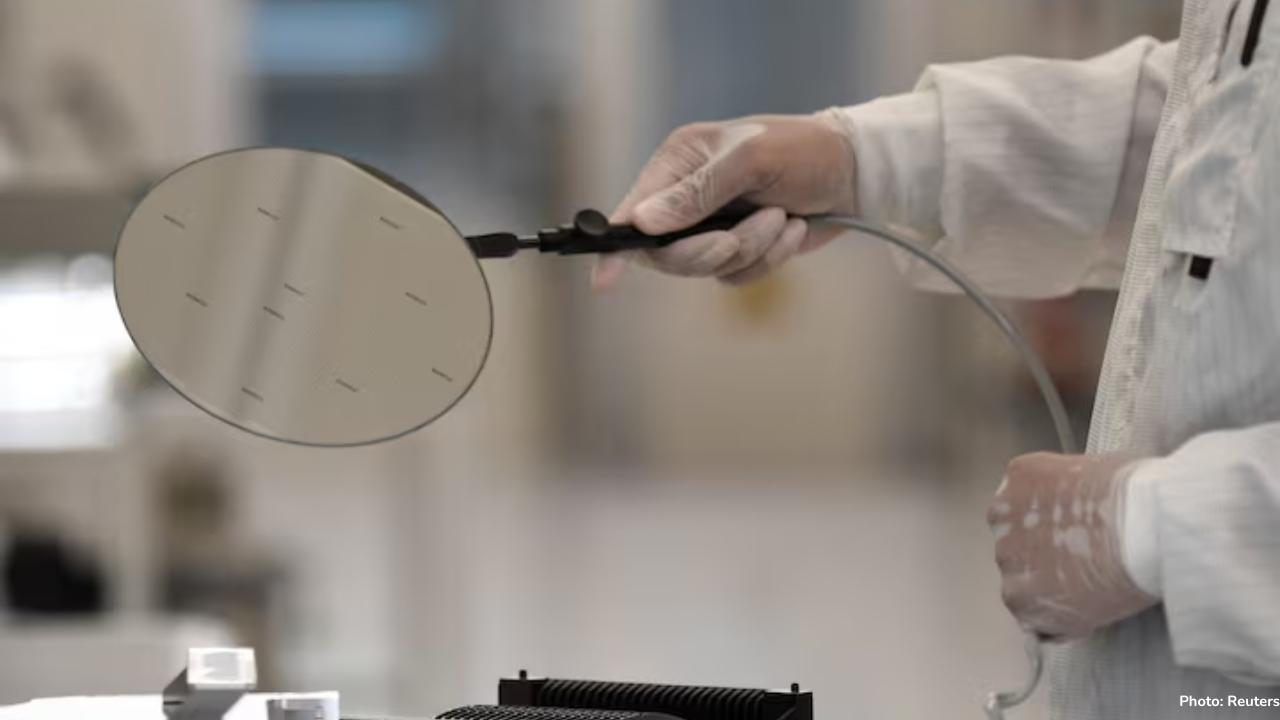
Post by : Naveen Mittal
On its latest mission, Blue Origin has once again made history. The NS-36 suborbital flight, conducted under its New Shepard program, marked the company’s 15th human spaceflight and 36th successful mission overall.
Carrying six passengers aboard, the rocket soared beyond the Kármán line — the internationally recognized boundary of space at about 100 kilometers (62 miles) above Earth — offering around 10 minutes of weightlessness before safely returning to West Texas.
This mission not only reaffirmed Blue Origin’s reliability in human spaceflight but also showcased the growing maturity of the commercial space tourism industry. As competition with SpaceX and Virgin Galactic intensifies, Blue Origin’s NS-36 flight highlights a future where short, accessible trips to space may soon be as routine as international flights.
The New Shepard program — named after astronaut Alan Shepard, the first American in space — embodies Blue Origin’s vision of making space travel safe, affordable, and repeatable.
Developed by Jeff Bezos’ Blue Origin, the fully reusable rocket and capsule system is designed for suborbital missions, carrying both humans and research payloads to the edge of space.
Each flight follows a simple yet revolutionary model:
The rocket booster propels the crew capsule upward beyond the Kármán line.
The capsule separates and offers several minutes of weightlessness.
Both booster and capsule return autonomously to Earth — the booster via vertical landing, and the capsule via parachute-assisted descent.
With NS-36, Blue Origin once again demonstrated this precise reusability cycle, reducing waste and operational costs while maintaining impeccable safety standards.
The NS-36 mission lifted off from Blue Origin’s private launch site in West Texas, under clear skies and ideal weather conditions. The mission carried six passengers, including one notable space science educator, two private tourists, and several first-time flyers.
Total Flight Duration: Approximately 11 minutes from liftoff to landing
Apogee (Peak Altitude): Around 105 kilometers (65 miles)
Microgravity Experience: Roughly 10 minutes of weightlessness
Crew Capsule Landing: Soft touchdown via three parachutes and retro-thrusters
Booster Recovery: Vertical landing on the designated pad
The NS-36 mission reaffirmed New Shepard’s flawless launch and landing performance, marking another milestone in its streak of successful recoveries.
Inside the capsule, the six passengers experienced the ultimate thrill of human spaceflight — floating freely above Earth, witnessing the thin blue curve of the planet’s atmosphere, and viewing the black expanse of space.
Each seat in the capsule offers a large panoramic window, the biggest ever flown in space, allowing passengers to enjoy breathtaking views while capturing photos and videos.
During their few minutes in microgravity, the crew conducted light experiments, released small mementos, and shared exclamations of wonder — a tradition aboard Blue Origin flights that celebrates the human connection to space.
Upon descent, parachutes deployed smoothly, followed by retro-thrusters cushioning the capsule’s landing. The recovery team quickly reached the site to greet the returning astronauts, marking the mission as flawless from liftoff to landing.
The NS-36 mission was far more than just another trip to the edge of space — it represented a critical continuation of Blue Origin’s long-term strategy for commercial human spaceflight.
With 15 crewed flights now completed safely, Blue Origin continues to build one of the most reliable records in private human spaceflight. Consistency and reliability are vital for gaining customer confidence and expanding the market.
The NS-36 booster and capsule were both reused components, underscoring Blue Origin’s goal of creating fully reusable launch systems. Each successful recovery further validates the company’s engineering approach toward sustainable operations.
For the public and potential space tourists, every successful mission reinforces the idea that space travel can be safe, predictable, and accessible — not just a one-time stunt.
Alongside tourism, Blue Origin offers payload opportunities for scientists and universities to conduct microgravity experiments. NS-36 carried several research payloads, including biological samples and fluid dynamics tests.
This combination of commercial passengers and scientific research continues to define New Shepard’s dual mission — exploration and education.
Founded in 2000 by Amazon’s Jeff Bezos, Blue Origin operates under the guiding principle of “Gradatim Ferociter” — Latin for “Step by Step, Ferociously.”
Unlike competitors racing for publicity, Blue Origin’s philosophy emphasizes slow, steady progress rooted in engineering perfection.
Over two decades, the company has achieved:
Repeated vertical landings of rocket boosters
Development of BE-3 and BE-4 engines, key to future heavy-lift systems
Successful integration of humans into suborbital spaceflight
A blueprint for future orbital and lunar missions
The NS-36 flight represents another step in this incremental yet visionary path — moving from suborbital testing to future orbital ambitions under the upcoming New Glenn rocket program.
While both involve space travel, suborbital and orbital flights have distinct purposes and technical differences.
Suborbital flights like NS-36 reach space but do not complete a full orbit around Earth. They follow a vertical trajectory, peaking above the Kármán line before descending back.
In contrast, orbital missions require higher speeds (around 28,000 km/h) to sustain continuous motion around Earth — a feat that requires far more energy, fuel, and complex reentry systems.
Suborbital missions thus offer a cost-effective way to provide space access — ideal for training astronauts, testing systems, and enabling the public to experience microgravity without the complexity of orbital missions.
The NS-36 flight highlighted Blue Origin’s ongoing mastery of reusable spaceflight engineering.
The New Shepard booster is capable of multiple launches and landings, with minimal refurbishment between missions. Its propulsion system, the BE-3PM engine, burns liquid hydrogen and liquid oxygen, creating clean water vapor exhaust — a nod to Blue Origin’s focus on sustainability.
The capsule, designed for maximum safety, includes:
An abort system that can instantly separate from the rocket in emergencies
Pressurized cabins with minimal pilot intervention
Touchscreen-based interfaces for crew monitoring
Advanced environmental systems ensuring passenger comfort
This reusable design drastically reduces costs, increases flight frequency, and supports Blue Origin’s goal of routine human access to space.
The NS-36 mission reinforces Blue Origin’s leadership in commercial suborbital tourism, a sector expected to grow exponentially by 2030.
Companies like Blue Origin, Virgin Galactic, and SpaceX are competing for early adopters — wealthy tourists, scientists, and influencers eager for the ultimate experience.
While Virgin Galactic uses a spaceplane launched from a carrier aircraft, Blue Origin’s rocket-based vertical flight provides a more authentic astronaut experience — including vertical launch acceleration, true microgravity, and capsule reentry.
Each flight ticket, priced at roughly $400,000–$500,000, grants passengers access to the rarest of human experiences: viewing Earth from space.
As flight frequency increases and costs decrease, space travel could become the next evolution of luxury adventure tourism.
Beyond tourism, Blue Origin’s suborbital platform is an invaluable tool for scientific research.
NS-36 carried multiple experiments from universities and startups studying fluid behavior, combustion, and biological processes in microgravity. These insights can lead to advances in materials science, medicine, and spacecraft design.
Blue Origin also uses its missions to inspire young scientists through the Club for the Future, a nonprofit organization that sends postcards from students to space and back, symbolizing humanity’s dreams for the future.
The NS-36 flight carried thousands of these postcards — a small but powerful gesture linking education and exploration.
The success of NS-36 is part of a broader vision that extends beyond suborbital space.
Blue Origin’s next big leap is New Glenn, a heavy-lift orbital rocket capable of carrying satellites and crewed missions to orbit. Its first stage is also reusable, designed to compete with SpaceX’s Falcon 9.
Blue Origin’s Blue Moon lander program — in partnership with NASA’s Artemis initiative — aims to deliver astronauts and cargo to the lunar surface later this decade.
The company’s long-term goal includes developing orbital habitats for sustained human presence in space, paving the way for space-based industry and settlement.
The steady progress of the New Shepard program is essential groundwork for these ambitious projects — testing reusability, safety, and human systems in real conditions.
Blue Origin’s NS-36 success comes amid an increasingly competitive private spaceflight race.
SpaceX focuses on orbital missions and Mars colonization.
Virgin Galactic targets luxury suborbital experiences.
Blue Origin bridges both, focusing on suborbital accessibility today while developing orbital and lunar ambitions for tomorrow.
What sets Blue Origin apart is its systematic engineering philosophy — prioritizing reliability and sustainability over speed. While other companies chase records, Blue Origin’s consistency in safe human launches builds trust for long-term dominance.
The NS-36 mission drew global attention across social media and news outlets. Passengers shared emotional reactions upon landing, describing their moments of awe as they gazed at Earth’s curvature and the infinite blackness of space.
Public enthusiasm around each flight reflects growing interest in commercial space access. What once felt like science fiction is now a tangible, purchasable experience.
The consistent media coverage also underscores Blue Origin’s role in making space a part of human culture, not just science.
Blue Origin’s NS-36 marked the company’s 15th human spaceflight and 36th overall mission.
The crew experienced 10 minutes of microgravity beyond the Kármán line.
The New Shepard system’s full reusability was demonstrated once again.
The mission advanced commercial space tourism and scientific research.
Blue Origin continues to build toward orbital and lunar missions through New Glenn and Blue Moon.
This article is for informational purposes only. The details summarized are based on current data from Blue Origin’s NS-36 mission and may evolve with future updates. Technical specifications and flight data are subject to confirmation by official company releases and scientific reports.
blue origin, ns-36 mission, new shepard, suborbital flight, human spaceflight, space tourism, reusable rockets, commercial space, jeff bezos, aerospace innovation










Lazio Denies Qatari Sale Rumors, Files Legal Complaints
Lazio refutes online claims of Qatari takeover talks, files reports with Italian regulators and judi

Penn State Fires Coach Franklin After Third Straight Loss
Penn State parts ways with James Franklin after 3 conference defeats, naming Terry Smith as interim

Denmark Beats Greece 3-1 to Stay Top in Qualifiers
Denmark wins 3-1 at home over Greece, keeps unbeaten record, and stays ahead of Scotland in Group C

Panthers Edge Cowboys 30-27 with Dowdle’s Big Game
Rico Dowdle dominates former team with 239 total yards as Panthers win 30-27 over Cowboys by last-se

Mariners Beat Blue Jays 3-1 to Win ALCS Game 1
Seattle shuts down Toronto’s bats and wins Game 1 of the ALCS 3-1, with strong pitching and timely h

Dutch Government Seizes Control of China-Owned Chipmaker Nexperia
The Netherlands government steps in over governance risks at Nexperia, suspends its Chinese parent’s